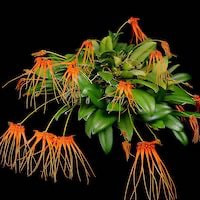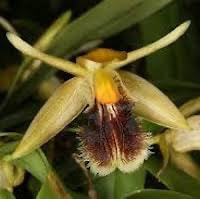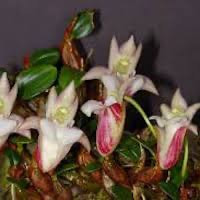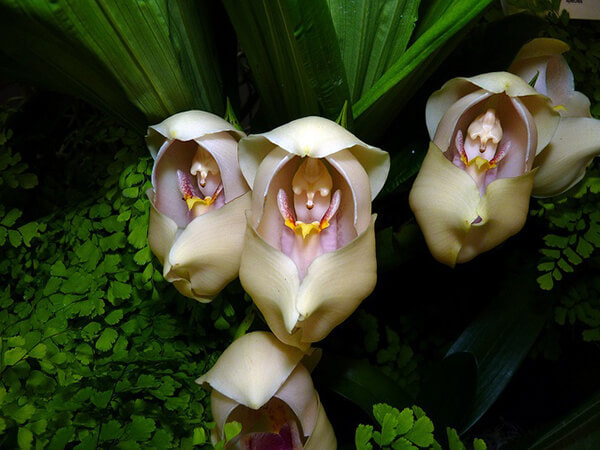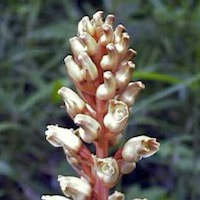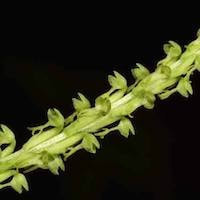WFL8 - Women's Floral 8 - The Frangipani Project
|
Native Singaporean Orchid notes: Eria Javanica
Eria Javanica, also known as the Javanese Eria or Xiang Hua Mao Lan in China, is an orchid species that thrives in warm-to-cool climates across Asia. Valued for its year-round flowering and delicate creamy yellow star-shaped flowers, it is a popular choice for gardens and orchid farms. Its captivating and pleasing fragrance makes it a favorite ingredient in perfumery, including the Floral 8 (Women) perfume used in team-building workshops. The Javanese Eria's adaptability and enchanting scent highlight its significance in the fragrance industry.
|
Therapeutic Orchid notes:
|
Bulbophyllum pectenveneris
Bulbophyllum pectenveneris, known as Huanghuajuanban Lan or Huanghuashitou Lan in Chinese, is a unique orchid species valued for its scent and medicinal uses. In traditional Chinese medicine, it is believed to improve circulation and relieve pain in joints, muscles, and bones, thanks to its analgesic and anti-inflammatory properties. The orchid’s pleasant and captivating aroma makes it a popular ingredient in perfumes. Its therapeutic benefits and appealing scent make Bulbophyllum pectenveneris a treasured plant in both medicine and the fragrance industry. |
|
Coelogyne fimbriata Lindl.
Coelogyne fimbriata, known as Liusubeimu Lan in Chinese and Ngwe hnin phyu myo kywe in Myanmar, is a unique orchid valued for its distinctive scent and medicinal uses. In Chinese herbal medicine, this orchid is used for its cooling properties, believed to balance body heat and relieve heat-related conditions. Its pleasant, floral fragrance makes it a popular ingredient in perfumes and scented products. Found in regions like Hainan and Yunnan, Coelogyne fimbriata’s appealing scent and medicinal benefits make it significant in both traditional medicine and perfumery. |
|
Dendrobium fargesii Finet. syn. Epigeneium fargesii (Finet) Gagnep
Dendrobium fargesii, known as Danyehouchun Lan, Maihu, Guoshangye, and Shi Lan in Chinese, and Lian Zhu Lan and Xiao Pan Long in Taiwanese, is a versatile orchid with notable therapeutic and aromatic qualities. In traditional herbal medicine, it is used to clear heat and moisten dryness, treating respiratory issues like coughs, bronchitis, and pneumonia, as well as conditions like gastritis and night sweats. Its pleasant, floral scent enhances perfumes, making it valuable in both medicine and the fragrance industry. |
|
Eulophia ochreata Lindl.
In India, the pseudobulbous terrestrial orchid Cymbidium aloifolium is known as Amarkand or Singadyakand. Endemic to Peninsular India, this orchid's tubers are used in traditional medicine for various health conditions. Phytochemical studies have found that a compound from the tubers has anti-inflammatory effects without disrupting cellular processes. In Mumbai, the juice treats rheumatism, while in Rajasthan, a mix of its powdered tubers and Chlorophytum borivilianum is used to boost the immune system and as an aphrodisiac. The tubers are also used to purify the blood and help with leukemia. |
|
Gastrodia elata Blume
In China, Gastrodia elata, known as Tianma (Heaven’s Fiber) and other names like Ming Tianma and Chi Jian, is a traditional medicinal orchid with a history dating back to the Han Dynasty. Its flowering season is from May to July across China. This orchid’s tuber is used in Traditional Chinese Medicine (TCM) for conditions such as headaches, high blood pressure, stroke, and rheumatism. Tianma also aids in postpartum blood circulation and treats skin issues like pruritus and dermatitis. Phytochemical studies have found 47 compounds in Gastrodia elata, with ongoing research into its potential use in skin whitening cosmetics. |
|
Herminium lanceum (Thunb. ex Sw.) Vuijk
Orchis graminifolia, also known as Shuangchunjiaopan Lan in Chinese and Yaozicao in medicine, is a terrestrial herb that grows in forests, thickets, and rocky slopes at elevations of 1100–3500 m. It flowers from June to August in mainland China and at different times in Taiwan, Sikkim, Bhutan, and Nepal. In traditional herbal medicine, the root is used to treat tuberculosis, strengthen muscles and bones, and stop bleeding. It is also used in India as a nutrient and tonic, with a decoction made from 6–15 grams of the herb. |
Other scent note
English Marigold, Freesia, Geranium, Mimosa, Heather, Narcissus, Pansy, Rose hip, Safflower, Violet, Jasmin
Scentopia Library Reference ingredient
Rose - Check details at Scentopia's scent library
Download the guided mediation that works best with this Orchid fragrance oil
| women_floral_essential_oil_orchi_00008.mp3 | |
| File Size: | 115217 kb |
| File Type: | mp3 |
Join Scentopia's wonderful orchid scent crafting, fragrance tour, bridal shower or corporate team building which includes perfume making onsite and offsite, beach activities and more. We also serve primary school learning journey, secondary students and pupil on industrial excursions. Know more about our orchids perfume bar or therapeutic orchid scents and other wellness aromas. Conatct Perfume workshop or book a scent crafting session here.

